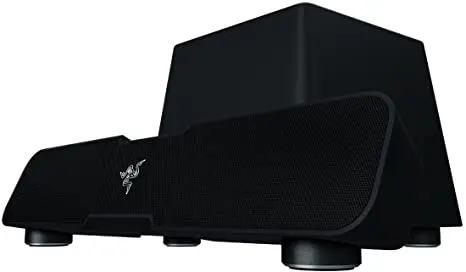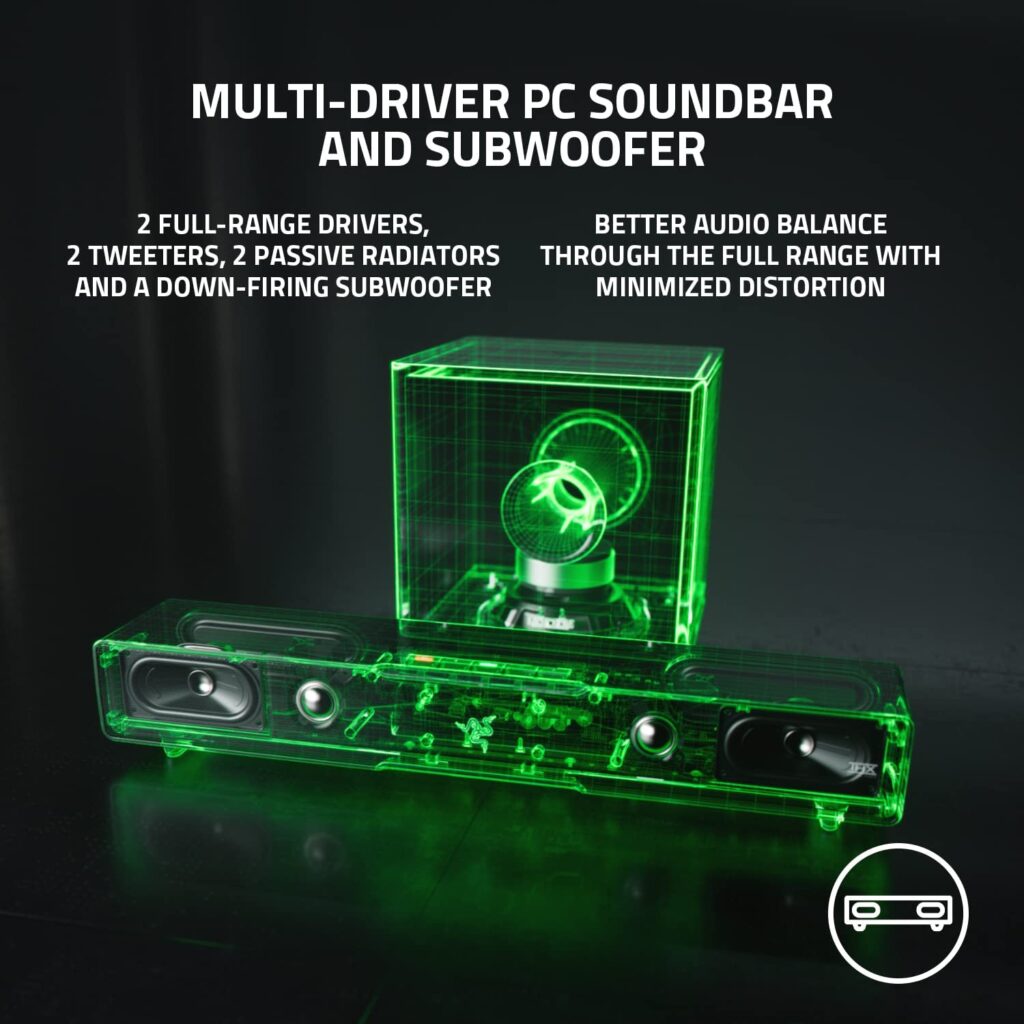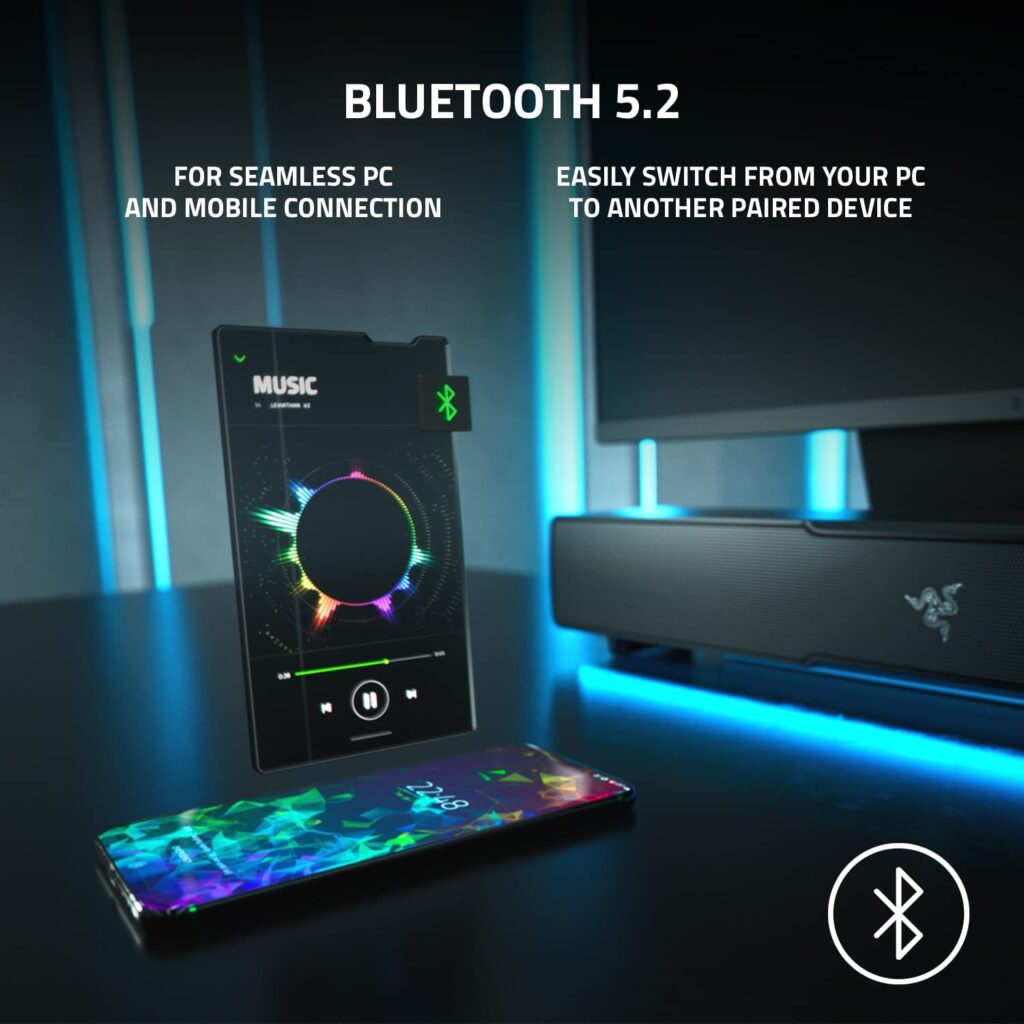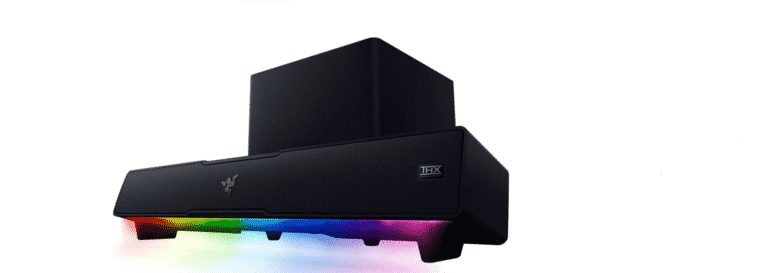The Razer Leviathan V2 gives every PC gamer’s favorite soundbar a much-needed revamp with one of the best computer audio experiences you’ll find right now, and it’s not even close.
While not inexpensive, the Leviathan V2 provides a fantastic soundscape at an affordable price, probably making this one of the greatest PC speakers available today. It isn’t without flaws, though, as the lack of 3.5mm and optical input effectively confines the Leviathan V2 to your PC, though it does offer Bluetooth connectivity, so you have some options.
Its THX Spatial Audio function is a nice touch, as well as the bass response both from the subwoofer as well as the soundbar is excellent. This is aided in part by the Leviathan V2’s longer form factor, which allows passive radiators to be used to increase the audio range, which you’ll notice when playing the top PC games.
Many gamers will like the addition of customizable 18-zone RGB lighting, especially since Razer Synapse allows you to sync the lights to respond to in-game activities and combine them into your larger RGB gaming scene.
Because there aren’t many gaming soundbars just on market, a Leviathan V2 is certainly one to consider if you want to take a break from your top PC gaming headsets and enjoy some room-filling audio. Although it is more expensive than some other computer speaker systems, the Razer Leviathan V2 is undoubtedly worth the money.
What you will see here?
Price and availability

It Razer Leviathan V2 came on the market on April 21, 2022, in the United States, the United Kingdom, & Australia, and other countries across the world.
It will set you back $249 / £229 / AU$449, which is a little more than the model it replaces (now $229 / £174 / AU$379, up from the $199 / £159 / AU$279 you observed during the Razer Leviathan.
Considering that its counterpart publishes about a decade earlier, some rising prices are to expect, and there are a few visible upgrades here that warrant a price increase.
Design

This Razer Leviathan V2 has received some improvements over its predecessor. The soundbar’s internal controls are quite muted, and it still has the signature Razer black and green accents look.
As you’d expect from the Razer product, the build quality is excellent. Even though practically the entire device is made out of plastic, it doesn’t seem cheap in the least.
The soundbar is now somewhat deeper than in its predecessor, and the most significant design modification is the switch to a true cube shape again for the subwoofer, as opposed to the semi-cube of the V1.
The Leviathan V2’s feet may also change out to allow the soundbar to angle upward instead of straight out at table level. The soundbar’s front grill is made of solid plastic with a Razer emblem imprinted in the middle.
With the exception of the RGB lighting, the soundbar easily fits under most displays. It is innocuous enough that it can easily blend into your desktop workspace.
Meanwhile, the subwoofer is a plain-looking plastic cube with a down-firing trumpet to push out bass. It’s also a lot bigger and more difficult to conceal. Unless you put it under your desk on the floor (If you live in apartments that aren’t on the ground floor, your neighbors will love you when you do this). Unfortunately, because it connects to the subwoofer, it can’t move too far from the soundbar.
Razer Leviathan V2: Features

This Razer Leviathan V2 offers a few innovative features to the series while also removing a few fan favorites.
Then there’s THX Spatial Audio, which goes beyond simple stereo to produce a much more immersive surround sound experience. It performs a decent job, but it’s not as good as Dolby Atmos. That you’d find in a home theatre soundbar. This isn’t surprising, given that Leviathan V2 is substantially less expensive than the top soundbars on the market that fully utilize Dolby Atmos.
The inclusion of Chroma RGB should also be a pretty clear signal that the Leviathan V2 is a gamer’s soundbar, not an audiophile’s. 3.5mm & optical audio inputs were permitted on the earlier Leviathan model. The Leviathan V2 does away with them in favor of a single-payer USB Type-C port. While you can also connect your phone or other Bluetooth-capable devices to the Leviathan. These are nice to have but are not the direction that Razer is taking their new soundbar.
The Leviathan V2’s inclusion of Chroma RGB also should serve as a clear indication that it’s a gamer’s soundbar, not an audiophile’s. The Leviathan V2 replaces the original Leviathan model’s 3.5mm & optical audio inputs with a single USB Type-C connector. While you can link your phone or even other Bluetooth-enabled gadgets to the Leviathan. They are merely nice-to-haves and are not the focus of Razer’s latest soundbar.
These restrictions irritate a lot of people. However, it actually designed to be a soundbar for PC games, not a replacement for a home audio system. Logically, Razer would take this path because nearly every gamer’s PC would have a USB Type-C port, if not numerous.
Performance

That’s all well and good, but how will the Razer Leviathan V2 sound?
The soundscape provided by the Leviathan V2 is truly one of the best audio experiences. You’ll get anywhere close to this price range, thanks to the multitude of speakers on both the soundbar and subwoofer. Whatever you want to do, whether it’s gaming, blaring music, or viewing new Netflix movies in between gaming sessions. It’s going to be incredible.
The Leviathan V2’s low-end performance improve significantly over its predecessor. Because of the formation of 2 passive radiators on the soundbar. That delves deep into the 45Hz range, as opposed to the 180Hz of a Leviathan V1.
The full-range speakers and tweeters easily occupy the gap, as well as a switch within Synapse options, may direct sound to the center channel. Ensuring that you get the most out of your audio when seated at your workstation.
Razer Leviathan V2: Connect at the Gaming time
When gaming, though, it’s preferable to connect the soundbar directly to the PC rather than via Bluetooth. Even though the Bluetooth latency is modest (60ms), it is large enough to cause some synchronization loss during gaming. Even if it is minor, this will irritate some people.
The THX Spatial Audio performs an excellent job of generating a surrounding sound experience. This is especially useful in gaming when ambient audio cues are vital, such as during a competitive match. And, while it isn’t exactly relevant to Dolby Atmos requirements. It doesn’t have to be if you’re being completely honest. Spatial audio is a bonus at this price, and the fact that it’s so skill to handle makes this a definite win for Razer.
Unless you’re looking for a way to connect the Razer Leviathan V2 to your TV or household audio system. You’re not going to be very disappointed. And if you’re searching for computer audio that’s not going to strap to your head for such a change. The Razer Leviathan V2 should not only be on your shortlist. But you should just get it.
Conclusion
With a soundbar intended for gamers, Razer is onto something: the fake panoramic sound and booming bass boosted the gaming experience. At this price, few soundbars include a subwoofer; for instance, JBL’s $200 SB100 just includes the primary soundbar. The Leviathan lacks the adjustments. You’ll need to achieve the greatest sound and the remote to manage the volume in a living room or other circumstances where you’ll be far from the TV. Consider the Yamaha YAS-203 or Sony HT-CT370 for extra versatility. It’s a good match if you like bass and only need to use the Razer Leviathan V2 at a close distance.
Read more:
- New Nintendo Switch V2 compared to the original!
- Google Glass Explorer Edition XE V2 Review-Augmented Reality Glasses!
- Replace your home theatre with JBL Bar 5.1!
- Increase your sound quality with the best soundbar!
- Spatial Audio in AirPods Pro- Surround Effect, Open and Immersive
















